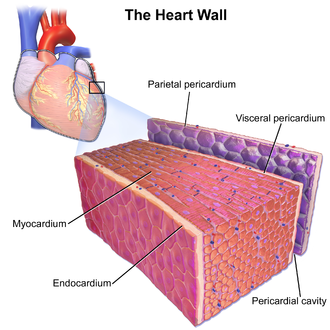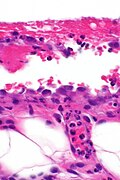Difference between revisions of "Pericardium"
Jump to navigation
Jump to search
| Line 55: | Line 55: | ||
*Infectious pericarditis. | *Infectious pericarditis. | ||
*[[Malignant mesothelioma]].<ref name=pmid23773902/> | *[[Malignant mesothelioma]].<ref name=pmid23773902/> | ||
====Images==== | |||
<gallery> | |||
Image: Acute pericarditis -- intermed mag.jpg | AP - intermed. mag. (WC) | |||
Image: Acute pericarditis -- high mag.jpg | AP - high mag. (WC) | |||
Image: Acute pericarditis -- very high mag.jpg | AP - very high mag. (WC) | |||
</gallery> | |||
===Sign out=== | ===Sign out=== | ||
Revision as of 21:29, 22 December 2015
Pericardium is a specimen that uncommonly comes to pathology.
Pathologies of the pericardium
Benign
- Idiopathic pericarditis - common.[1]
- Infectious pericarditis - post-procedural.
- Fibrinous pericarditis.
- Pericardial cyst.
Malignant
Related pathologies
- Pericardial effusion.
- Hemopericardium.
- Cardiac tamponade.
Specific entities
Idiopathic pericarditis
General
- Uncommon.
Etiologies of pericarditis:[2]
- Infectious:
- Fungal.
- Bacterial.
- Idiopathic - most common.
- Neoplastic.
- Autoimmune, e.g. systemic lupus erythematosus.
- Uremia - chronic renal failure.
- Traumatic - post-surgical.
- Associated with myocardial infarction - Dressler's syndrome.
Gross
Features:[2]
- Thickening.
- +/-Pericardial effusion.
Notes:
- Normal pericardial fluid volume 5-35 mL.[2]
Microscopic
Features:
- Inflammatory cells:
- Neutrophils.
- Lymphocytes.
- Plasma cells.
- +/-Hemosiderin-laden macrophages.
DDx:
- Infectious pericarditis.
- Malignant mesothelioma.[1]
Images
Sign out
PERICARDIUM, BIOPSY: - ACUTE AND CHRONIC PERICARDITIS WITH SIDEROPHAGES AND REACTIVE MESOTHELIAL CHANGES. - NO MICRO-ORGANISMS SEEN WITH ROUTINE STAINING. - NO EVIDENCE OF MALIGNANCY.
Micro
The sections show fibrous tissue with minimal adipose tissue that is covered by mesothelium. A mixed inflammatory infiltrate is present that consists primarily of lymphocytes and plasma cells. Rare eosinophils are seen. Focally, neutrophils are seen and associated with reactive mesothelial cells. Abundant hemosideratin-laden macrophages are seen. No fibrinous strands are seen. No significant nuclear atypia is identified and no atypical infiltrative cell population is identified. No micro-organisms are identified with routine staining.
See also
References
- ↑ 1.0 1.1 Smets P, Guettrot-Imbert G, Hermet M, et al. (September 2013). "[Recurrent pericarditis related to primary pericardial malignant mesothelioma]" (in French). Rev Med Interne 34 (9): 573–6. doi:10.1016/j.revmed.2013.04.021. PMID 23773902.
- ↑ 2.0 2.1 2.2 2.3 2.4 Peebles CR, Shambrook JS, Harden SP (December 2011). "Pericardial disease--anatomy and function". Br J Radiol 84 Spec No 3: S324–37. doi:10.1259/bjr/16168253. PMC 3473919. PMID 22723538. https://www.ncbi.nlm.nih.gov/pmc/articles/PMC3473919/.



